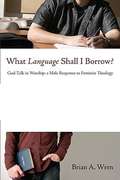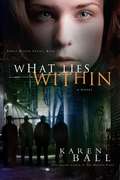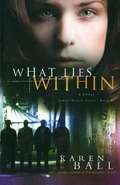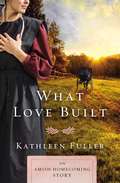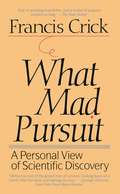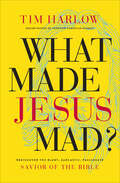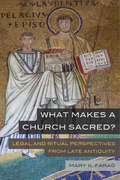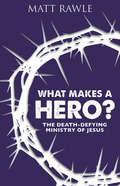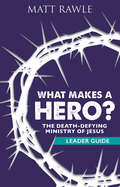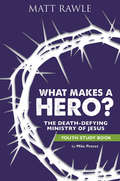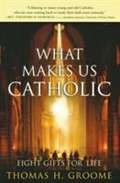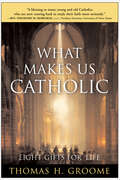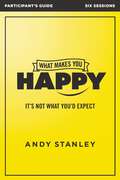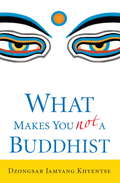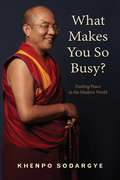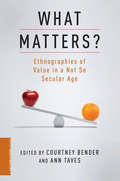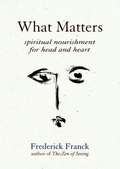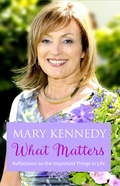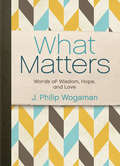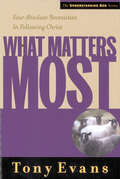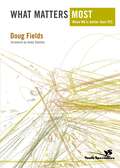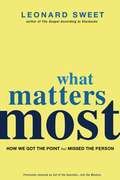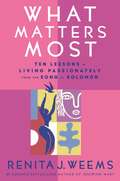- Table View
- List View
What Language Shall I Borrow?: A Male Response to Feminist Theology
by Brian A. WrenThe author of this book writes from the experience of being English, white, male, and heterosexual, and as one who values the Reformed tradition and has been shaped and enriched by it.
What Lies Within (Family Honor Series #3)
by Karen BallNothing's going to stop Kyla... until the ground crumbles beneath her feet. Kyla Justice has arrived. Her company, Justice Construction, is one of the most critically acclaimed, commercially successful companies in the Pacific Northwest. And yet, something is missing. Not until she's called on to build a center for inner-city kids does she realize what it is: her sense of purpose. Now nothing can stop her, not the low budget, not supply problems, not gang opposition, not her boyfriend's suggestion that she sell her business and marry him-and most especially not that disagreeable Rafael Murphy. Rafe Murphy understands battle. Wounded in action, this Force Recon Marine carries the scars-and the nightmares-to prove it. Though he can't fight overseas any longer, he's found his place as a warrior in the civilian world. So he soldiers on, trusting that one of these days, God will reveal to him why Rafe survived the ambush in Iraq. That day has arrived. Kyla and Rafe both discover that determination alone won't carry them through danger and challenges. When gang violence threatens their very foundations, there's only one way to survive: rely on each other, be real-and surrender to God. In other words, risk everything...
What Lies Within (Family Honor Series Book #3)
by Karen M. BallKyla Justice's name means "victorious." But that's the last thing she feels. Having fought long and hard to establish her construction business, her schedule is now full of plans for malls and subdivisions, but her heart is empty. Where are the projects that matter? Then she's given the opportunity to build a center for inner-city kids. The obstacles don't stop her: opposition from area gangs, minimal funding, hesitant and deceptive suppliers, even the man who claims to love her and would marry her---if she would sell her business. Soon things get messier and lives are endangered. Will Kyla learn to accept what lies within her and rely on others not just to succeed, but to survive?
What Love Built: An Amish Homecoming Story
by Kathleen FullerAn Amish Homecoming story from bestselling author Kathleen Fuller.Carolyn Yoder left her home in Birch Creek ten years ago. Presented with the opportunity to pursue a lifelong dream, she moves back to start a new life and a new business. Independent and headstrong, Carolyn is determined to forge ahead with the opening of her bakery, but she’s in over her head and needs help with the cleaning, shopping, and deliveries.Atlee Shetler hasn’t been able to get over the loss of his wife, so he decides to move away from the memories of his hometown and settle in Birch Creek. A carpenter by trade, he takes a job renovating the new bakery and finds the project—and its owner—to be much more than he bargained for. Atlee has his work cut out for him, professionally and romantically.Through God’s help and healing, Carolyn and Atlee find peace, love, and a brighter future than either of them imagined.
What Love Remembers
by Muncy G. ChapmanSet on the outer Florida Islands, this is a Christian romance by a popular Christian romance writer
What Mad Pursuit: A Personal View of Scientific Discovery
by Francis CrickCandid, provocative, and disarming, this is the widely-praised memoir of the co-discoverer of the double helix of DNA.
What Made Jesus Mad?: Rediscover the Blunt, Sarcastic, Passionate Savior of the Bible
by Tim HarlowWhile Christians love to focus on a gentle, tender Jesus, Harlow offers an unforgettable reintroduction to the true character of Jesus and invites us to get to know the savior who was gracious but also blunt, sometimes sarcastic, and wildly passionate about bringing people to the heart of God. We often don&’t know what to do with the Bible&’s stories of Jesus' righteous rage. Yet the truth is, while the Son of God was loving and tender, his words could be equally sharp and biting. The same man who said, &“Love your enemies&” (Matthew 5:44) also said, &“You snakes, how will you escape being condemned to hell?&” (Matthew 23:33). With compelling storytelling and enlightening examinations of Scripture, Tim Harlow journeys through the gospels and looks at what, and who, ignited Jesus&’ anger. He guides us through instances of Jesus&’ anger in response to the barriers people put up:in the temple, where money changers literally denied access to the Father, especially for the non-Jews and the poor;during his teaching, when little children were denied access;on the Sabbath, when religious leaders put rules above relationship and suffering above healing; and many more.What if, Harlow asks, by coming to understand God&’s holy anger, we come to know a savior we never knew before? How can we respond like Jesus when good intentions, prejudices and judgments, traditions and rules, and selfish and joyless people conspire to keep others from God&’s presence?
What Makes a Church Sacred?: Legal and Ritual Perspectives from Late Antiquity (Transformation of the Classical Heritage #63)
by Mary K. FaragA free open access ebook is available upon publication. Learn more at www.luminosoa.org. What is the purpose of a church? Who owns a church? Mary K. Farag persuasively demonstrates that three groups in late antiquity were concerned with these questions: Christian leaders, wealthy laypersons, and lawmakers. Conflicting answers usually coexisted, but from time to time they clashed and caused significant tension. In these disputes, juridical regulations and opinions mattered more than has been traditionally recognized. Considering familiar Christian controversies in novel ways, Farag’s investigation shows that scholarship has misunderstood well-known religious figures by ignoring the legal issues they faced. This seminal text nuances vital aspects of scholarly conversations on sacred space, gift giving, wealth, and poverty in the late antique Mediterranean world, making use not only of Latin and Greek sources but also Coptic and Arabic evidence.
What Makes a Hero?: The Death-Defying Ministry of Jesus (What Makes a Hero?)
by Matt RawleWhat Makes a Hero? offers us an image of what it looks like to be victorious over trials and temptations. Looking at pop culture heroes and others through the lens of faith, Matt Rawle shows how Jesus turned the concept of hero on its head. In keeping with his theme “Pop in Culture,” the book examines how good vs. evil, right vs. wrong, and overcoming adversity are fundamental to how Christians understand salvation. Heroes help us discern the good, fight for what’s right, define identity, execute justice, spark revolution, and save lives. Rawle enters the Gospel story to tell quite a different victory story—one obtained through humility, obedience to the cross, and an empty tomb. How does Jesus redefine what it means to be a hero? Additional components for a six-week study include a comprehensive Leader Guide, a DVD featuring Matt Rawle, a Worship Resources Flash Drive, and youth and children resources.
What Makes a Hero? Leader Guide: The Death-Defying Ministry of Jesus (What Makes a Hero?)
by Matt RawleWhat Makes a Hero? offers us an image of what it looks like to be victorious over trials and temptations. Looking at pop culture heroes and others through the lens of faith, Matt Rawle shows how Jesus turned the concept of hero on its head. In keeping with his theme “Pop in Culture,” the book examines how good vs. evil, right vs. wrong, and overcoming adversity are fundamental to how Christians understand salvation. Heroes help us discern the good, fight for what’s right, define identity, execute justice, spark revolution, and save lives. Rawle enters the Gospel story to tell quite a different victory story—one obtained through humility, obedience to the cross, and an empty tomb. How does Jesus redefine what it means to be a hero? The Leader Guide contains everything needed to guide a group through the six-week study, including session plans and discussion questions, as well as multiple format options.
What Makes a Hero? Youth Study Book: The Death-Defying Ministry of Jesus
by Matt RawleWhat Makes a Hero? offers us an image of what it looks like to be victorious over trials and temptations. Looking at pop culture heroes and others through the lens of faith, Matt Rawle shows how Jesus turned the concept of hero on its head. In keeping with his theme “Pop in Culture,” the book examines how good vs. evil, right vs. wrong, and overcoming adversity are fundamental to how Christians understand salvation. Heroes help us discern the good, fight for what’s right, define identity, execute justice, spark revolution, and save lives. Rawle enters the Gospel story to tell quite a different victory story—one obtained through humility, obedience to the cross, and an empty tomb. How does Jesus redefine what it means to be a hero? This Youth Study Book takes the ideas presented in Matt Rawle’s book and interprets them for young people grades 6-12.
What Makes Us Catholic: Eight Gifts for Life
by Thomas H. GroomeWhat makes a Catholic a Catholic? According to Thomas Groome, an expert on the essential ingredients of Catholic Christianity, Catholics share certain vital features of life and identity. What Makes Us Catholic explains and illuminates that character, and invites Catholics of all kinds to connect more deeply and imaginatively with their own culture and spirituality.
What Makes Us Catholic: Eight Gifts for Life
by Thomas H. Groome“[A] celebration of what is beautiful and lasting in the Catholic tradition . . . a kiss of peace to [all] Catholics, whether liberal, conservative, or confused.” —Michael Leach, co-editor of I Like Being CatholicWhat makes a Catholic a Catholic? According to Thomas Groome, a professor in theology and religious education at Boston College, Catholics share certain vital features of life and identity. What Makes Us Catholic explains and illuminates that character, and invites Catholics of all kinds to connect more deeply and imaginatively with their own culture and spirituality.“Eloquently contends that all Catholics be they faithful adherents or lapsed members share eight distinctive qualities . . . To each Groome dedicates a skillfully written chapter, which opens with an anecdote from his own experience that concretizes its theological subject. Readers will find themselves pausing and engaging in the text with questions for reflection and conversation . . . Groome [keeps] complex religious jargon to a minimum, allowing his simple stories to resonate in the heart.” —Library Journal“Grounded in the actual experiences of people, [this book] portrays Catholicism as a rich, multi-faceted reality that cannot be contained by any single doctrine or institutional element.” —Richard P. McBrien, author of Lives of the Saints
What Makes You Happy Bible Study Participant's Guide: It's Not What You'd Expect
by Andy StanleyEverybody wants to be happy. Everybody is on a happiness quest. For many, happiness is measured in moments. Experiences. It's elusive. Unsustainable. What about you? What makes you happy? Something comes to mind for each of us.In this six-session video Bible study, pastor Andy Stanley examines the ways in which we tend to define happiness and explains how that definition influences the way we pursue it. He reveals that happiness is about who, not what, and that happy people are at peace with God, with others, and with themselves. He also shows how sin undermines peace because it separates us from God, others, and ourselves by substituting pleasure for fulfillment, things for people, images for intimacy, and self-expression for self-control.We are often tempted to believe that happiness comes from acquiring things, but happiness is actually an outcome of what we sow in our lives. We can&’t acquire, consume, or exercise our way to happiness, but we may be able to serve and volunteer our way there. In the end, we find that if we live as if it&’s all about us, we will never be happy.Sessions include:NothingPlan for ItPeace with GodHappy MoneyShoesYou&’re Not EnoughDesigned for use with the What Makes You Happy DVD (sold separately).
What Makes You Not a Buddhist
by Dzongsar Jamyang KhyentseSo you think you're a Buddhist? Think again. Tibetan Buddhist master Dzongsar Jamyang Khyentse, one of the most creative and innovative lamas teaching today, throws down the gauntlet to the Buddhist world, challenging common misconceptions, stereotypes, and fantasies. With wit and irony, Khysentse urges readers to move beyond the superficial trappings of Buddhism--beyond the romance with beads, incense, or exotic robes--straight to the heart of what the Buddha taught.
What Makes You So Busy?: Finding Peace in the Modern World
by Khenpo SodargyeA Tibetan Buddhist lama gives advice on the issues facing people in the modern world.In this book, Khenpo Sodargye, a world-famous Tibetan Buddhist lama and scholar, offers guidance on an issue that troubles so many of us in the modern world: What is true happiness, and how do we achieve it? Bombarded with information, endlessly pursuing possessions—we look for happiness in all the wrong places. Khenpo Sodargye, one of the busiest Buddhist teachers in the world, shows us how to redirect our attention away from such distractions and instead calm our minds and find true contentment. His wide-ranging advice covers careers and conventional notions of material success, romantic relationships, and the environment. Erudite and compassionate, he points the reader to inspiration from sutras, Zen masters, Confucius, and the daily news, offering warm, heartfelt encouragement for these troubled times.
What Matters?: Ethnographies of Value in a Not So Secular Age (A Columbia / SSRC Book)
by Courtney Bender Ann TavesOver the past decade, religious, secular, and spiritual distinctions have broken down, forcing scholars to rethink secularity and its relationship to society. Since classifying a person, activity, or experience as religious or otherwise is an important act of valuation, one that defines the characteristics of a group and its relation to others, scholars are struggling to recast these concepts in our increasingly ambiguous, pluralistic world.This collection considers religious and secular categories and what they mean to those who seek valuable, ethical lives. As they investigate how individuals and groups determine significance, set goals, and attribute meaning, contributors illustrate the ways in which religious, secular, and spiritual designations serve as markers of value. Reflecting on recent ethnographic and historical research, chapters explore contemporary psychical research and liberal American homeschooling; the work of nineteenth and early-twentieth-century American psychologists and French archaeologists; the role of contemporary humanitarian and volunteer organizations based in Europe and India; and the prevalence of highly mediated and spiritualized publics, from international psy-trance festivals to Ghanaian national political contexts. Contributors particularly focus on the role of ambivalence, attachment, and disaffection in the formation of religious, secular, and spiritual identities, resetting research on secular society and contemporary religious life while illuminating what matters in the lives of ordinary individuals.
What Matters: Spiritual Nourishment for Head and Heart
by Frederick FranckAfter his nearly 100 years of seeding, Franck's reflections on what really matters will help you to savor what truly matters in your own life. "Could the meaning of being born human be, to become Human?" This elegantly simple book of reflections presents the rich harvest of a lifetime of thinking, feeling, and seeing by an artist, whose vital spirituality has inspired hundreds of thousands of readers and students through his art, books, and workshops. The pithy, sometimes humorous, always wise contemplations reveal Franck's lifelong confrontation with the human in himself and others. Originally jotted down as reflections for himself and close friends, Franck's insights will challenge you to consider new ways of experiencing your spiritual path and to savor what truly matters.
What Matters: Reflections on Important Things in Life
by Mary KennedyIn this book of consideration and appreciation, best-selling author and broadcaster Mary Kennedy takes stock of her life and those things most important in it. She considers what makes us strong, and how we can develop resilience in the world through knowing ourselves from within, and knowing our roots. She considers the nature of family and friendship too, and how a mother's role changes over time.Food, fashion, beauty - 'the eyes of the heart' - and the creative arts are all explored, along with honest reflections on the challenges and uncertainties of life, and how we maintain hope and faith in the face of loss. Ultimately, she asks how, as we get older, we can change our world for the better, for those who follow in our footsteps.What Matters is the perfect bedside book to read for solace and inspiration - and the ideal gift for someone important in your life.
What Matters: Words of Wisdom, Hope, and Love
by J. Philip WogamanIn this “letter” to the next generation, Wogaman, a pastor, ethicist, and grandfather draws on a wealth of experience to share what truly matters. Today’s young people yearn for authenticity and truth. However, the important aspects of truth, character, politics, community, family, education, religion, and vocation can get muddled by our cultural experiences. This book offers the opportunity to learn something from an older generation’s experience of what matters—and about what doesn’t matter much. What Matters addresses our broader cultural issues in the twenty-first century world. Explore why many young people have become disillusioned, even cynical, about major aspects of contemporary life. Wrestle with why is it hard to accept religious assumptions that were simply taken for granted in an earlier era. Contemplate the difficulty of seeing beyond the self-serving of many politicians. Come to appreciate why religious, political, economic, and educational institutions still matter. By tackling our tough questions about today’s world, we can come to better understand what’s truly worth believing in, and how our decisions and actions build a life that matters.
What Matters Most: Four Absolute Necessities in Following Christ (Understanding God Ser.)
by Tony EvansDo you want to be challenged to deepen your understanding of the characteristics and requirements of Almighty God? The Understanding God Series contains the bulk of Pastor Tony Evans' compelling and hard-hitting resources on the essentials about God, Jesus Christ, the Holy Spirit, Spiritual Warfare, and prophecy. Now available in paperback, readers will not want to be without a single book in the series by this popular and powerful speaker and author.What are the central precepts a person should know to fully follow Christ? As only he can, Tony Evans very clearly presents what he terms 'four absolute necessities' to following the Lord. Readers will be led into a more intense, passionate walk with Christ as they come to understand what's required.
What Matters Most: Four Absolute Necessities in Following Christ (Understanding God Ser.)
by Tony EvansDo you want to be challenged to deepen your understanding of the characteristics and requirements of Almighty God? The Understanding God Series contains the bulk of Pastor Tony Evans' compelling and hard-hitting resources on the essentials about God, Jesus Christ, the Holy Spirit, Spiritual Warfare, and prophecy. Now available in paperback, readers will not want to be without a single book in the series by this popular and powerful speaker and author.What are the central precepts a person should know to fully follow Christ? As only he can, Tony Evans very clearly presents what he terms 'four absolute necessities' to following the Lord. Readers will be led into a more intense, passionate walk with Christ as they come to understand what's required.
What Matters Most: When NO Is Better Than YES
by Doug FieldsThis small book will call to you on days that the janitor reads you the riot act, the church secretary jumps down your throat and those home school parents just won’t leave you alone. In this book, Doug Fields shares the wisdom that has helped him survive over 25 years in ministry: Just say No. That two letter word (that often feels like a four letter word to some people!) has the power to help you stay in ministry for the long haul and keep your family intact and thriving. From the book: Jesus said “no” to good things… “no” to significant things… “no” to important people. He was 100%God/100% human and he had limits. He needed solitude. He needed time to reflect and pray and nourish his spiritual life and time away from those bonehead disciples. He needed space. And, Jesus had a lot to do. You try being the Savior of the world! He had a short window to accomplish his life mission and yet he seemed to prioritize and live so different than we do. To say “no” in ministry is to be radical…to be radical is to be counter-cultural…to be counter-cultural is to be like Jesus…to be like Jesus should become our goal.
What Matters Most: How We Got the Point but Missed the Person
by Leonard SweetBelief can exist in isolation, but faith requires a relationship Why wade in the shallows of belief when you can plunge into the depths of faith? Belief involves a different way of thinking, but faith brings about a new way of living. It grows through direct experience and a close relationship, both of which come as you follow Jesus. As Christians we often talk about developing a "personal relationship" with Christ, but instead of pursuing a relationship, we pursue knowledge. We are tempted to place confidence in our definite, settled beliefs, which offer a pale substitute for the daily adventure of an honest relationship with Jesus. In What Matters Most, Leonard Sweet presents a challenging and compelling approach to belief that is joined by dynamic engagement with God. You are invited to explore the uncharted regions of faith by following Jesus, completely on his terms. Once you begin, you will never go back to mere belief.From the Trade Paperback edition.
What Matters Most: Ten Lessons in Living Passionately from the Song of Solomon
by Renita J. WeemsOffering ten lessons relevant to today, "Essence" #1 bestselling author Weems draws inspiration from the Song of Solomon to examine the role passion plays in women's lives.
